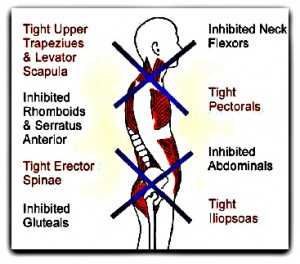The fascial planes in our body start at the top of the head and run all the way down to the bottom of the feet. Because of these long sheets of tissue, any type of structural or functional deviation will create compensation, deterioration, and pain within the body. By addressing the body as a whole, you will be able to find solutions to those pesky problems that keep recurring.
Correcting your posture is a process of reminding your body of proper position
Bones do what muscles tell them to do, so postural balance or imbalance is a muscle issue. Motion is critical for the body to maintain its muscle strength and balance. When the body’s posture is balanced all motion is positive. When the body deviates from its design then many motions and activities can become negative stressors to the body. This can show up as a degenerative joint, muscle tightness or spasm, disc herniation, or migraine headache.
What is Posture?
If we look at the standing normal anatomical position we see that the human body is designed to be perfectly balanced from left to right. The human body has eight major load joints: the ankles, knees, hips, and shoulders which should be vertically aligned and parallel with each other. The torso and head should be centered. This allows for proper shock absorption and distribution of forces during all activities which creates positive stress on the body. This positive stress leads to increased bone and muscle mass.
How Neuromuscular Therapy brings balance to your life
So many of us get so used to moving through the activities of our daily lives that we no longer notice how we sit, stand or move through space; here, a little education goes an incredibly long way. By understanding the biomechanics of the body as well as the physical structure, a neuromuscular therapist can explain what a healthy body wants and how imbalances and the resulting dysfunction can stress the body, leading to any number of issues.
NMT helps you get out of pain because it mitigates the causes of soft-tissue pain.
•Do you suffer from a chronic stiff neck or low back, or have a limited range of motion in your shoulder? According to the American Academy of pain management; back pain is the leading cause of disability in Americans under 45 years old. More than 26 million Americans between the ages of 20-64 experience frequent back pain.
•Are your activities limited because of a persistent pain in your elbows or knees?
If so, please continue to read this page. It explains a “new” and very successful approach to treating “body aches and pains”, whether acute or chronic, whether originating from unknown causes or an accident or sports injury.
Vladimir Janda, MD.(1923-2002), a Czech neurologist and physician, was an expert in musculoskeletal pain syndromes. He helped to develop the now increasingly popular philosophy of “manual medicine”, a European perspective on the relationship between bodily form and function. He defined characteristic muscular imbalance patterns that lead to chronic pain and disability.
Improve Postural Balance with Neuromuscular Therapy
 The following figures show Janda’s model for understanding the most common postural distortions. These models illustrate the relationship between muscular “pairs”, and the potent role they play in producing neuromuscular dysfunction and pain.
The following figures show Janda’s model for understanding the most common postural distortions. These models illustrate the relationship between muscular “pairs”, and the potent role they play in producing neuromuscular dysfunction and pain.
As a simplified example, in the Upper Crossed Model, the muscles in the chest and front of the neck are too tight, whereas the muscles between the shoulder blades and the back of the shoulders are lacking in tone or are “over stretched”. The Lower Crossed Model shows abdominals and gluteals as lacking tone, with the muscles on the fronts of the thighs and the low back being overly tight (or “short”).
As a therapist I utilize these models in my NMT practice to restore clients to postural balance, which in turn greatly reduces or entirely eliminates most soft-tissue pain syndromes. You might be able to recognize yourself or your office neighbor in these schematics. If so, understand that the postural deviations you are noticing are the prescription for pain in the future, if the pain is not already manifested.
Also, recognized and addressed are dysfunctional patterns and adaptation that take place. For example in the sequence of events which include compensation and adaptation responses in many muscles, then followed by the evolution of a variety of possible syndromes involving head/neck, TMJ (Jaw), shoulder/arm or others.
Most non-traumatically caused soft-tissue pain syndromes are the result of chronic postural problems and associated life-style issues, like exercise, nutrition, proper sleep patterns, etc. Looking at a pain syndrome from the “whole person” perspective is very important.
For example, Fibromyalgia, which afflicts an estimated 3 to 6 million people in the U.S. alone, is thought to be caused by improper muscle metabolism and decreased blood flow, which predictably causes fatigue and weakness.
Increase mobility and blood flow which, in turn, increases a sense of muscular relaxation, vitality, strength and well being, schedule your visit and see what this transformational therapy is about.
Conditions helped by NMT
Muscle Spasm Using Ice or Heat
The effects of Poor Posture Chronic Forward Head
Neck Pain Carpal Tunnel Syndrome
Thoracic Outlet Syndrome Jaw/Hip/Back Pain
Headaches/Migraines Women’s health
Causes of Inflammation
Disclaimer: The information found throughout this website is for educational purposes only, please contact your physician for questions about your health.
[schedule_now]
